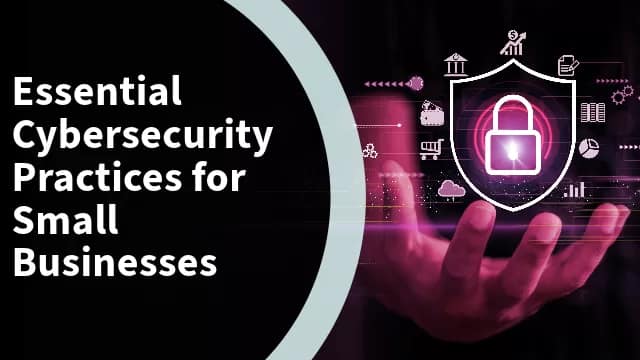In today’s interconnected world, cybersecurity is not just a concern for large corporations. Small businesses, too, are prime targets for cyberattacks. In fact, according to recent studies, 43% of cyberattacks specifically target small businesses. This article dives deep into the world of cybersecurity and unveils the essential cybersecurity practices that every small business should implement to protect its digital realm.
Introduction
In the digital age, small businesses are flourishing, but they are also facing an ever-growing threat landscape. Cybercriminals are constantly devising new ways to breach security defenses and steal sensitive data. To safeguard your business, it’s imperative to adopt robust cybersecurity practices. In this comprehensive guide, we’ll explore these practices in detail, ensuring you have the knowledge to protect your small business effectively.
Essential Cybersecurity Practices for Small Businesses
Assess Your Digital Landscape
Before fortifying your cybersecurity, you must understand your digital landscape. Perform a thorough audit of your online presence, identifying vulnerabilities, assets, and potential risks. This assessment serves as the foundation for your cybersecurity strategy.
Implement Robust Password Policies
Passwords are often the weakest link in cybersecurity. Enforce strong password policies among your employees. Encourage the use of complex, unique passwords and implement multi-factor authentication (MFA) for added security.
Conduct Regular Employee Training
Your employees can either be your strongest defense or your weakest link. Train them in cybersecurity best practices, including how to identify phishing attempts and avoid downloading malicious attachments.
Secure Your Network
A secure network is paramount. Use a firewall, regularly update your router’s firmware, and segment your network to minimize the risk of lateral movement by attackers.
Keep Software Up-to-Date
Outdated software is an open invitation to cybercriminals. Ensure that all software, including operating systems and applications, is regularly updated with the latest security patches.
Data Encryption
Implement data encryption protocols to protect sensitive information. Encrypt data both in transit and at rest to thwart potential data breaches.
Backup Your Data
Regular data backups are your safety net in case of a cyberattack. Ensure that backups are automated, stored securely, and regularly tested for reliability.
Establish an Incident Response Plan
Prepare for the worst-case scenario by creating a detailed incident response plan. This plan should outline the steps to take in the event of a security breach, minimizing damage and downtime.
Monitor and Detect Anomalies
Deploy intrusion detection systems and establish a routine for monitoring network traffic. Detecting anomalies early can prevent security breaches from escalating.
Vendor Security Assessment
Assess the security practices of third-party vendors who have access to your data. Ensure they meet your cybersecurity standards to prevent potential vulnerabilities.
Mobile Device Management
Incorporate a mobile device management (MDM) system to control and secure devices used by your employees for work purposes, ensuring they adhere to your cybersecurity policies.
Cyber Insurance
Consider investing in cyber insurance to mitigate financial losses in case of a data breach. This can provide valuable support during the aftermath of a cyberattack.
Regularly Audit and Update Policies
Cybersecurity policies should evolve with emerging threats. Regularly review and update your policies to stay ahead of potential vulnerabilities.
Employee Offboarding
When employees leave your organization, ensure they no longer have access to sensitive data. Implement a thorough offboarding process to revoke access promptly.
Security Awareness Campaigns
Launch regular security awareness campaigns within your organization to keep employees informed about the latest cybersecurity threats and best practices.
Secure Physical Access
Don’t overlook physical security. Ensure that servers and network equipment are stored in secure locations with limited access.
Business Continuity Planning
Prepare for the worst-case scenario with a robust business continuity plan. This ensures that even in the event of a cyberattack, your business can continue to operate.
Regularly Test Your Defenses
Conduct penetration testing and vulnerability assessments to identify weak points in your cybersecurity infrastructure, then address them promptly.
Incident Reporting
Establish a clear process for employees to report any suspicious activity promptly. Timely reporting can thwart potential threats.
Compliance with Regulations
Stay up-to-date with relevant cybersecurity regulations in your industry. Ensure your practices align with legal requirements.
Social Engineering Awareness
Train your employees to recognize and resist social engineering attempts, such as phishing, to prevent unauthorized access.
Develop a Cybersecurity Culture
Foster a culture of cybersecurity within your organization. Encourage employees to prioritize security in their daily work routines.
Collaborate with Cybersecurity Experts
Consider partnering with cybersecurity experts or consultants to ensure you’re following the latest best practices.
Disaster Recovery Planning
Prepare for data loss scenarios with a robust disaster recovery plan. This plan should encompass data restoration and system recovery.
FAQs
Q: What are the primary targets of cyberattacks on small businesses? A: Cyberattacks on small businesses often aim to steal sensitive customer data, disrupt operations, or use the business as a gateway to attack larger organizations.
Q: How can I encourage employees to follow cybersecurity best practices?
A: Employee training and awareness programs, along with clear policies and consequences for non-compliance, can motivate employees to adhere to cybersecurity best practices.
Q: Is cyber insurance essential for small businesses?
A: While not mandatory, cyber insurance can provide financial protection in case of a cyberattack, making it a valuable investment for many small businesses.
Q: What is multi-factor authentication (MFA), and why is it crucial?
A: MFA adds an extra layer of security by requiring users to provide multiple forms of verification before granting access, making it much harder for cybercriminals to breach accounts.
Q: How often should I update my cybersecurity policies?
A: Cybersecurity policies should be regularly reviewed and updated, at least annually, to address evolving threats and ensure they remain effective.
Q: What should I include in my disaster recovery plan?
A: A disaster recovery plan should outline procedures for data restoration, system recovery, and business continuity in the event of a cyberattack or data loss.
Conclusion
In an increasingly digital world, small businesses must prioritize cybersecurity. By implementing these essential cybersecurity practices, you can protect your business, customer data, and reputation from the ever-present threat of cyberattacks. Stay vigilant, stay informed, and stay secure.

